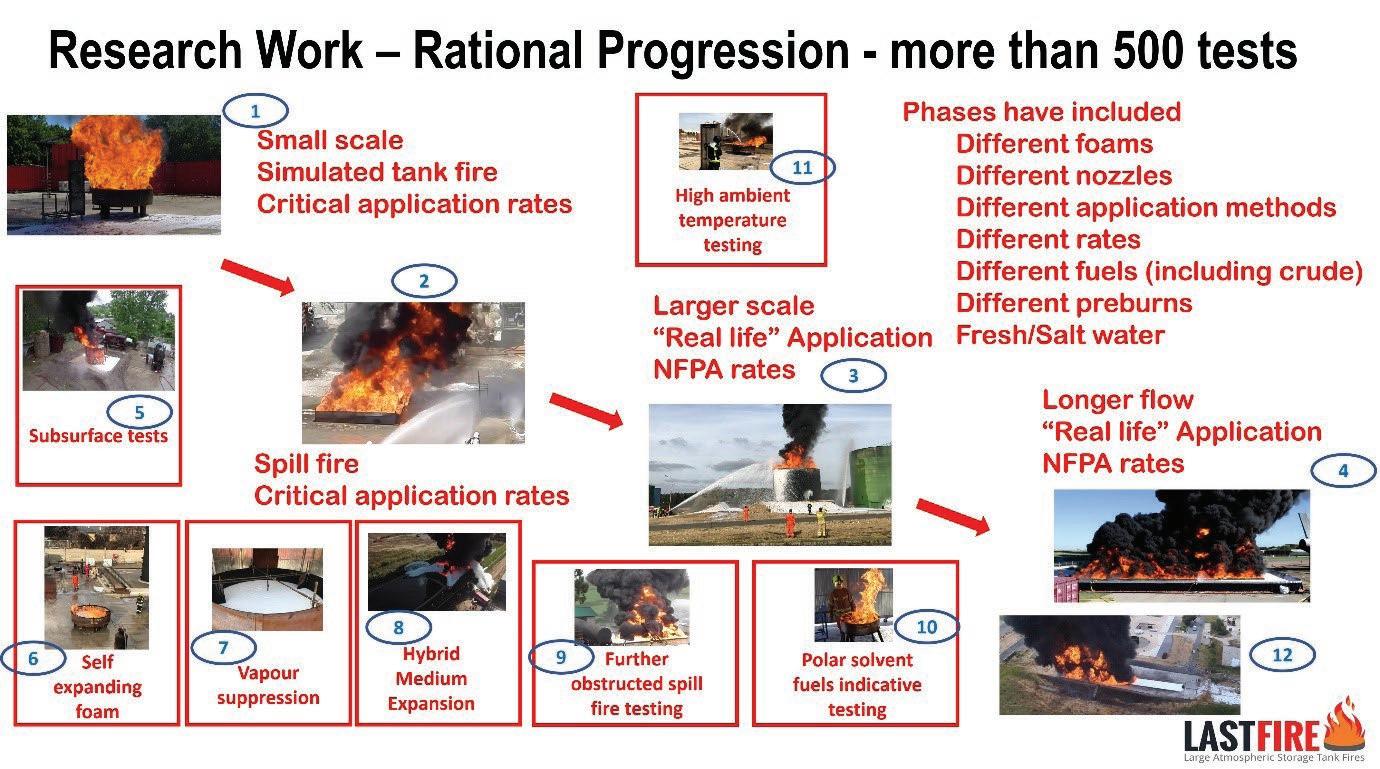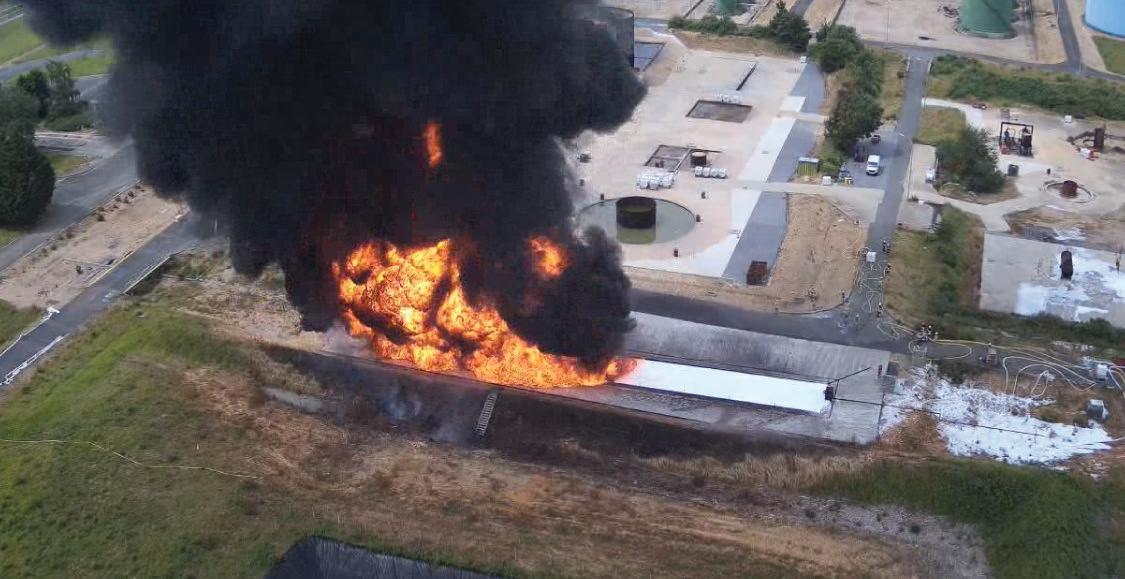
7 minute read
LASTFire: Transition to fluorine free foams
The transition to fluorine free foams is perhaps currently one of the biggest issues facing firefighting foam users. The issue is not only limited to industrial firefighters but applies across all users of foam. Large Atmospheric Storage Tank Fires (LASTFire), the industry group developing best practices in storage tank fire hazard management, has taken a pragmatic approach to the issue of a transition to fluorine free foam. It is recognised that it is inevitable, so work has focussed on making the process as cost effective and practicable as possible.
The opportunity has been taken to develop a much better database and understanding of critical foam performance criteria in order to optimise a foam’s performance through equipment design and application method as well as foam concentrate formulation.
It is recognised that there are many aspects to getting the transition right and ensuring sustainable system assurance, such as achieving correct proportioning rate and assessing environmental issues of replacement foams. LASTFire is developing guidance on all of them.
The most critical issue, though, is fire performance and LASTFire has carried out the most comprehensive set of industrial end-user driven, independently managed, tests to date.
LASTFire work is directed and reviewed by members and thus is truly relevant to ends user needs.

Background note
It should be noted that, for many years, LASTFire has been testing foam firefighting performance using the standard LASTFire test protocol. This is a test procedure designed specifically for assessing a foam’s performance for the critical conditions of a storage tank fire. This test was first developed by Mobil Research and Development Corporation (MRDC), recognising that most tests available were designed more for spill fire situations that did not reproduce these conditions. MRDC handed it over to LASTFire to complete its development and validate it against incident experience. Since then it has been used by a number of oil companies as part of their performance based procurement specification and factory acceptance testing protocols. Consequently, LASTFire has an extensive database of test results of per- and polyfluorinated substances (PFAS) based foams using this protocol which can also be used as comparison with the results obtained with fluorine free types. It is noted that the first fluorine free foams marketed struggled to perform well in this test but with developments by suppliers there are now several commercially available products that perform well against this protocol.
There has been correlation noted between the performance and issues noted in the standard LASTFire test with some foams, such as flames ‘ghosting’ over the fuel surface and that seen in the larger scale testing described here.
ENRg Consultants, as LASTFire coordinator, has spent several years working on the issue. Initially concentrating on foam performance, with small scale research understanding how these new formulations work compared to older C8 or C6-based formulations; working up through elevated tank testing (10m height, 11m diameter tank) to larger scale (50m flow length), developing an understanding of how to maximise efficiency and effectiveness of the foams through different application types and methods.
Recent LASTFire work in December 2022 moved away from fixed application devices (monitor and system pourer application) and focused on hands-on application carried out by arguably some of the most experienced industrial firefighting experts from around the world from LASTFire member organisations. The aim of this work was to assist with developing realworld guidance on how to optimise the use of fluorine free foam.
The tests involved gasoline (180m2; ~21 000l fuel with water base), E15 (15 percent Ethanol and gasoline mix) (200m2; ~21 000l fuel) and Ethanol (45m2; 6 000l fuel). Different hand held application equipment types including non-aspirated, low expansion and medium expansion were used at application rates typically less than NFPA standard rates and in some cases down to approximately 35 percent of NFPA rates, well below rates used in practice. Some tests involved direct comparisons of the different foams using the same application techniques, others involved simultaneous application of different foams from different handlines.
Application techniques included forceful application, ‘roll-on’ pushing foam on from the ground on to the front of the fire, ‘banking’ where foam is applied to hot objects that were located within the fire, additionally served the purpose of creating obstacles for the foam to flow around and ‘rain down’ where the foam nozzle was directed vertically to allow a gentle application of foam on to the surface. Four different foams were used and full extinguishment was achieved in all cases. The intention is that the data from these tests will be used to develop guidance on what application practices are effective and most suitable under different conditions/ stages of a fire.

Other issues
Whilst firefighting effectiveness is the most important issue for a firefighting foam there are many other aspects that must be considered when selecting the most appropriate agent and ensuring that it is applied as efficiently as possible. Consequently, LASTFire is also carrying out work in other areas including:
• Identification and analysis of critical foam parameters: expansion, stability, viscosity, flowability, fuel pick-up etc.
• Proportioning rate accuracy. LASTFire has carried out checks with a number of foams and different proportioner types including venturi line proportioners and water driven positive displacement pump types. This can be an issue and should be checked as part of the transition process on a case by case basis. However, it has been noted that developments by some suppliers have resulted in reduction in concentrate viscosity in some cases.
• Simultaneous application of different fluorine free foams on to the same fire. No issues of destruction of foam blanket due to interaction have identified with the combinations tested to date.
• Whilst not carrying out any work in their own right, LASTFire is constantly monitoring the situation regarding clean-up and disposal of PFAS in order to keep members up to date with best practices and latest developments.

Future work
LASTFire recognises that it is always useful to carry out more work and is in discussions with other industry sector groups with similar objectives to share information. It is undoubtedly the case that more test work is being requested for fluorine free foams than was done on previous foam generations, including ‘C6’ formulations. These ‘C6’ foams introduced after the implementation of the USA Environmental Protection Agency (EPA) PFAS Stewardship programme which introduced the concept of C6 PFAS formulations aimed at working towards zero C8 contents. LASTFire has seen definite reductions in performance in some cases with the introduction of these without it always being highlighted by the manufacturer.
The current plans of LASTFire include:
• Assessment of fluorine free foam for crude oil that has been burning for sufficient time to build up a hot zone
• Effectiveness of fluorine free foam on water soluble fuels at a larger scale
• Ongoing identification and optimisation of critical aspects of the foam/equipment combination
Summary
LASTFire has carried out a very comprehensive set of tests at both large and small scale. It is important to review these as a complete programme rather than take points from them piecemeal. To date nothing has been identified to suggest that fluorine free foams cannot be made to work for all required scenarios that have been conventionally managed by PFAS containing foams but there is still work to be done to optimise their performance and so minimise transition costs.
LASTFire is committed to filling any gaps in knowledge and to ongoing testing, working with other sectors to maximise the benefits from shared learning.
For more information on LASTFire work and copies of previous test reports, please contact: info@lastfire.org










